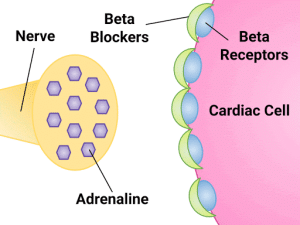1.1.6 Pharmacodynamics
Ernstmeyer & Christman - Open Resources for Nursing (Open RN)
Pharmacodynamics
So far in this chapter, we have learned the importance of pharmacokinetics in how the body absorbs, distributes, metabolizes, and excretes a medication. Now let’s consider how drugs act on target sites of action in the body, referred to as pharmacodynamics.
Mechanism of action is a medical term that describes how a medication works in the body. For example, did you know that an osmotic laxative like magnesium citrate attracts and binds with water? The mechanism of action for this medication is it pulls water into the bowel, which softens stool and increases the likelihood of a bowel movement.
A drug’s mechanism of action may refer to how it affects a specific receptor. Many drugs bind to specific receptors on the surface of cells to cause an action. For example, morphine binds to a specific receptor that inhibits transmission of nerve impulses along the pain pathway and decreases a client’s feelings of pain.
Other medications inhibit specific enzymes for a desired effect. For example, earlier in this chapter we discussed how monoamine oxidase inhibitors (MAOIs) are prescribed as antidepressants because they block monoamine oxidase, the enzyme that breaks down serotonin and dopamine. This blockage increases the concentration of serotonin and dopamine in the central nervous system and increases a client’s feelings of pleasure.
Agonist and Antagonist Actions
Drugs have agonistic or antagonistic effects on receptor sites. An agonist binds tightly to a receptor to produce a desired effect. An antagonist competes with other molecules and blocks a specific action or response at a receptor site. See Figure 1.7[1] for an illustration of how a beta-blocker, an antagonist cardiac medication, blocks specific action on the beta receptors of a cardiac cell.

Agonistic and antagonistic effects on receptors for common classes of medications are further discussed in the “Autonomic Nervous System” chapter.
Critical Thinking Activity 1.7
Atenolol (Tenormin) is an antagonist medication. Does the nurse anticipate this will cause a specific action or block a specific action at a receptor site?
Note: Answers to the Critical Thinking activities can be found in the “Answer Key” section at the end of the book.
Next- 1.1.7 Types of Medication
Media Attributions
- Mechanism of Action © Dominic Slauson
- ORN-Icons_internet-copy_internet-copy-300×300-1
- “Mechanism of Action” by Dominic Slausen at Chippewa Valley Technical College is licensed under CC BY 4.0 ↵
Connection between two neurons, or between a neuron and its target, where a neurotransmitter diffuses across a very short distance.
Abnormally low blood levels of thyroid hormones T3 and T4 in the bloodstream.
Chemical signals sent by the endocrine organs and transported via the bloodstream throughout the body where they bind to receptors on target cells and induce a characteristic response.
Anatomical division of the nervous system located within the cranial and vertebral cavities, namely the brain and spinal cord.

